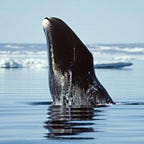Barrow Canyon: Ecosystem at the Top of the World
by: Kate Stafford
I am an oceanographer based at the University of Washington. Not unlike the animals I study, I have many times over the past decade migrated north and then south to and from Barrow, Alaska, in both spring and in fall to study the acoustic behavior of bowhead whales. On the scale of human occupation of the Arctic (millennia) or the lifetime of a bowhead whale (up to 200 years), the time I’ve spent in the Arctic over the past decade is merely the blink of an eye. But this, it turns out, is time enough to sense what a special place it is, and how ecologically rich. During this short time, though, this area has seen record lows in sea ice extent and thickness, increased fall storms and unpredictable spring sea ice conditions.
Spring
In April and May, the Chukchi and Beaufort Seas are frozen and the low gravelly land near Point Barrow is covered with snow. This is my favorite time of year. Everything is white and blue and cold and clear and the Arctic is awakening from its long dark winter. With east winds, or high tides and currents, the sea ice offshore opens into a canal of water (called a flaw lead) between the shore-fast and pack wraps around Point Barrow, usually over the deeper water of Barrow Canyon. It is through this lead that a migration to rival that of the Serengeti passes. Fifteen-thousand plus bowhead whales and several times that number of belugas move north and east from the Chukchi Sea into the Beaufort Sea, just around the tip of the Point. There are bearded and ringed seals in the lead, and just above it, thousands upon thousands of King and Common Eiders in flight. And even when the wind or current shifts, and the lead closes, still there is life moving below the ice.
The silence of the expanse of white and blue, with perhaps just a bit of black water and gray new ice, is a remarkable contrast to what you hear when a hydrophone (an underwater microphone) is lowered into the water through a hole punched near the lead edge. The overlapping trills of bearded seals, the screams and trumpets of bowhead whales, the high whistles of distant beluga whales, and the groaning of ice rubbing slowly against itself belie the silence above. These contrasting worlds provide completely different perspectives of the same environment.
This is why I am so drawn to Barrow in spring: the contrast between utter silence and cacophony, the seemingly static expanse of ice that might shift and radically change with no notice at all, or the combined delight and visceral fear of seeing the yellowish form of a polar bear clambering over or around a pressure ridge. This is not a place that “assaults” the senses — it is more subtle than that from the small delights of hearing the first snowbird of the year, to the buttery warmth of uunaalik (boiled maktak) eaten out on the ice, the sight of the first, or hundredth, bowhead whale of the season surfacing slowly to breathe, the cold sting of the air on exposed skin. It is through myriad small moments like these that this place has gotten under my skin; shards of magnetite that pull me northwards each year.
Fall
Nowadays, Chukchi and Beaufort Seas near Point Barrow are ice free in the fall. To venture out onto the sea, we take small boats that used to launch from inside Elson Lagoon before fall storms washed over the gravel road that leads north from Barrow on a regular basis. The colors of fall are nothing like spring — to gray skies, brown seas and shore, and vivid umber tundra that may be dotted with the “snow” of tundra cotton. The days grow shorter fast in fall and the brightly colored breeding plumage of the spring is gone from southbound flocks of Eiders.
Spring winds can help maintain open water. In the fall, increasing winds and storms make work on the water difficult to impossible. Days and weeks can go by without a single day on the water. When the weather does cooperate, though, a greater diversity of life in the Beaufort Sea and near Barrow Canyon makes the fall here as remarkable as spring. Out near the canyon, the water is usually a bit choppier, but it is an area where you always expect to see more of everything. Feeding grays whales trail plumes of mud as they surface, beluga whales puff and dive and bird diversity is high: Yellow Billed Loons, Kittlitz’s Murrelets, Murres, and Red Phalaropes are just a few species seen. Occasionally a small group of walrus, or a lone harbor porpoise might break the surface of the water. East winds (which are increasing in this region) promote the upwelling of nutrient rich water and krill onto the shelf near Barrow. If the east winds relax, the krill become “trapped” in densities sufficient for bowhead whales to pause their fall migration towards Chukotka, Russia, and feed off Barrow. Whales as long as the water is deep, swimming on their sides with mouths open and baleen splayed about in the air and krill popping at the surface like effervescence from orange soda, is a sight that may exist nowhere else on the planet.
About the author: Kate Stafford is an oceanographer with the University of Washington Applied Physics Laboratory. Her research focuses on the use of passive acoustic monitoring to study large whale species. The majority of her work is based in polar regions with a particular focus on the Arctic.
